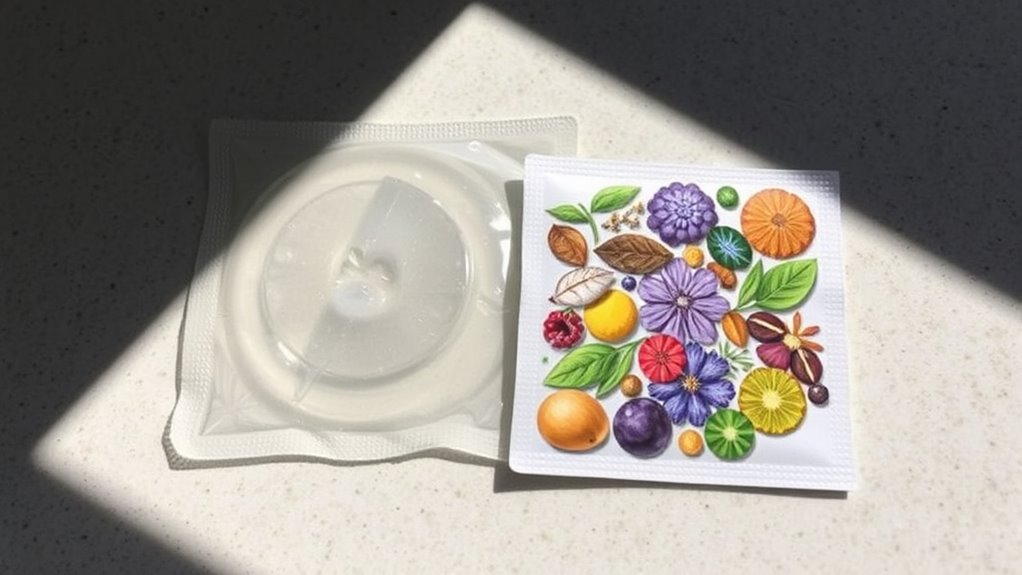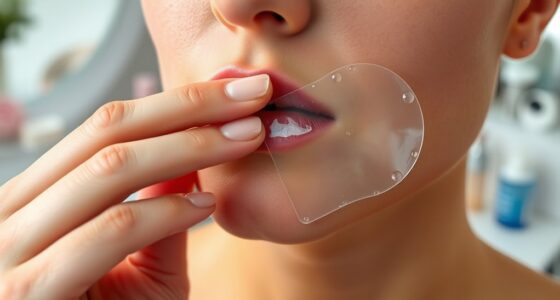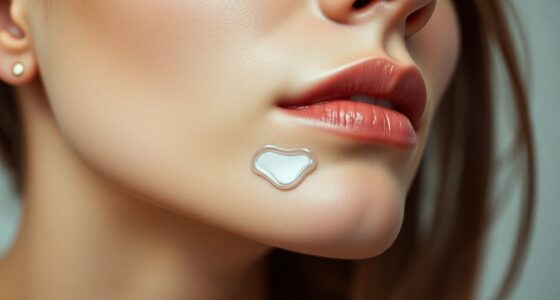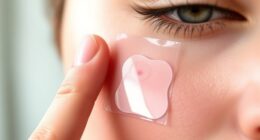When considering hydrocolloid patches versus other options, it’s important to know what’s in your pimple patch. Hydrocolloid patches are designed to absorb pus and promote healing in surface-level pimples. They create a moist environment that protects your skin. Other patches might contain active ingredients like salicylic acid or tea tree oil, targeting early-stage blemishes or deeper acne. Choosing the right patch can make a big difference, so explore your options for effective acne treatment. More insights await!
Key Takeaways
- Hydrocolloid patches primarily absorb fluid and promote healing for mature pimples with visible pus, while other patches may contain active ingredients for early-stage acne.
- Active ingredients like salicylic acid and benzoyl peroxide target acne-causing bacteria and help clear clogged pores, enhancing treatment effectiveness.
- Combination patches blend hydrocolloid technology with active ingredients for dual-action, addressing both surface-level and deeper blemishes.
- Hydrocolloid patches create a moist environment to protect against bacteria, while microdart patches deliver active ingredients beneath the skin for deeper treatment.
- Choosing the right patch depends on acne type, desired treatment effects, and individual skin needs, so assessing ingredients is crucial.
Understanding Hydrocolloid Patches
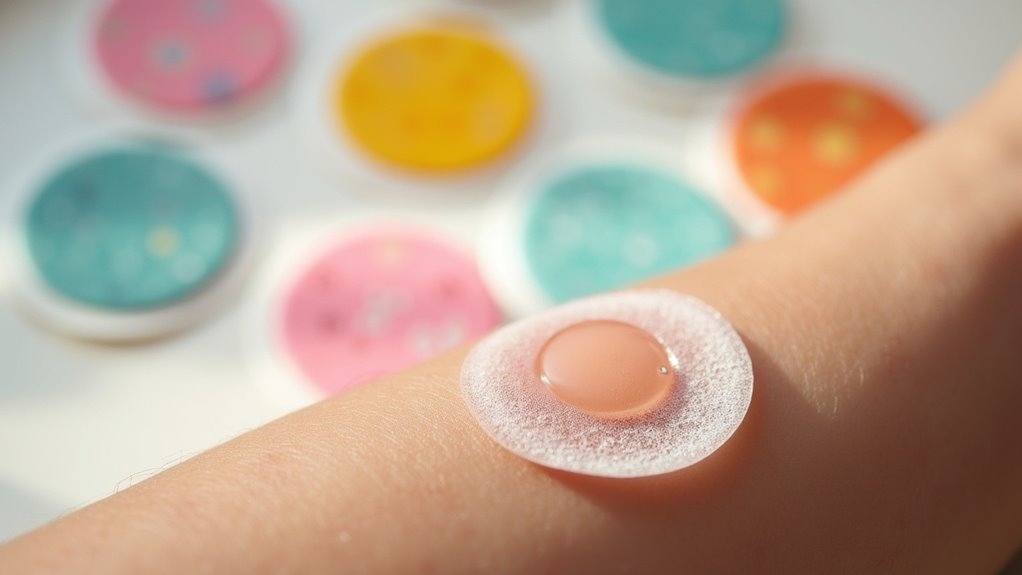
Hydrocolloid patches are a game changer for treating pimples, especially those pesky ones with visible white pus.
These innovative patches, made from gel-forming agents like pectin and gelatin, create a moist environment that promotes healing. They effectively absorb pus and fluids from your skin while keeping bacteria at bay.
By adhering to the affected area, these patches provide insulation, preventing external irritants from interfering with the healing process.
Unlike traditional treatments, hydrocolloid patches work discreetly, often available in clear or skin-toned options, so you can wear them day or night.
Studies show they outperform methods like surgical tape, greatly reducing acne severity and speeding up healing.
With hydrocolloid patches, you can tackle those stubborn pimples effectively.
The Role of Active Ingredients in Acne Treatment Patches
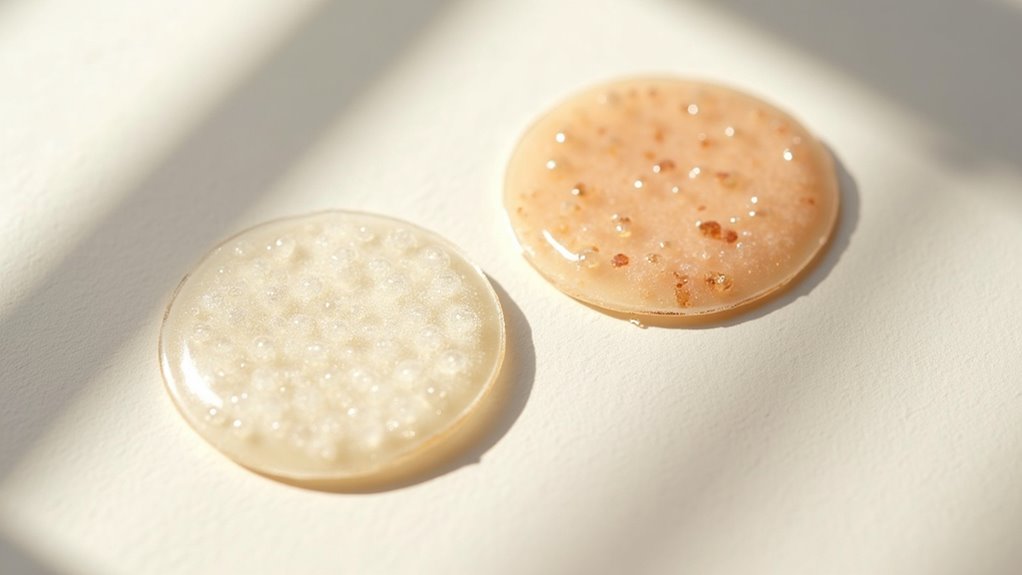
When you’re looking for effective acne treatment patches, the active ingredients they contain play an essential role in targeting breakouts.
Pimple patches often include salicylic acid, which helps exfoliate and clear clogged pores, making it ideal for inflamed pimples.
Tea tree oil, known for its antibacterial properties, can reduce redness and swelling, although it may irritate sensitive skin.
Benzoyl peroxide serves as a powerful antiseptic, tackling acne-causing bacteria and helping to prevent future breakouts.
These active ingredients work together, allowing hydrocolloid patches to absorb fluids and pus while promoting healing.
Hydrocolloid patches harness active ingredients to absorb pus and promote healing effectively.
Some patches also feature niacinamide for improved skin tone and hyaluronic acid to keep your skin hydrated throughout the acne treatment process.
How Hydrocolloid Patches Work
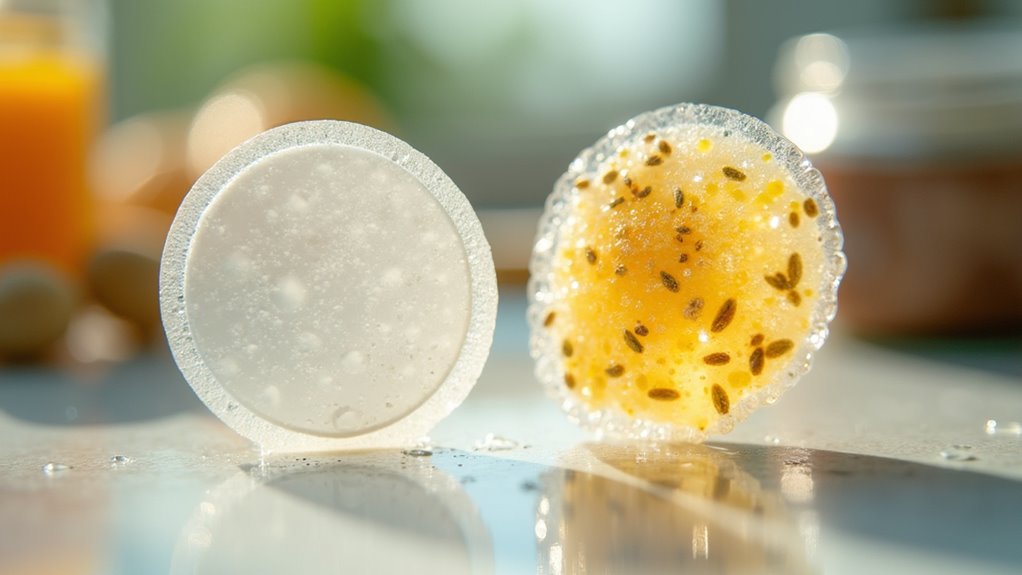
The secret to the effectiveness of these acne treatment patches lies in their hydrocolloid composition. Hydrocolloid patches utilize gel-forming agents like pectin and sodium carboxymethylcellulose to create a moist environment, which helps absorb excess fluid and pus from pimples.
When you apply these patches, they adhere to your skin and draw out impurities, effectively protecting your skin from acne-causing bacteria. This unique gel formation accelerates your body’s natural healing process, leading to visible results after use.
While they’re ideal for treating superficial acne lesions, remember they’re not suitable for deeper cystic acne or clogged pores. By using hydrocolloid patches, you can support your skin’s healing while minimizing irritation.
Different Types of Acne Patches
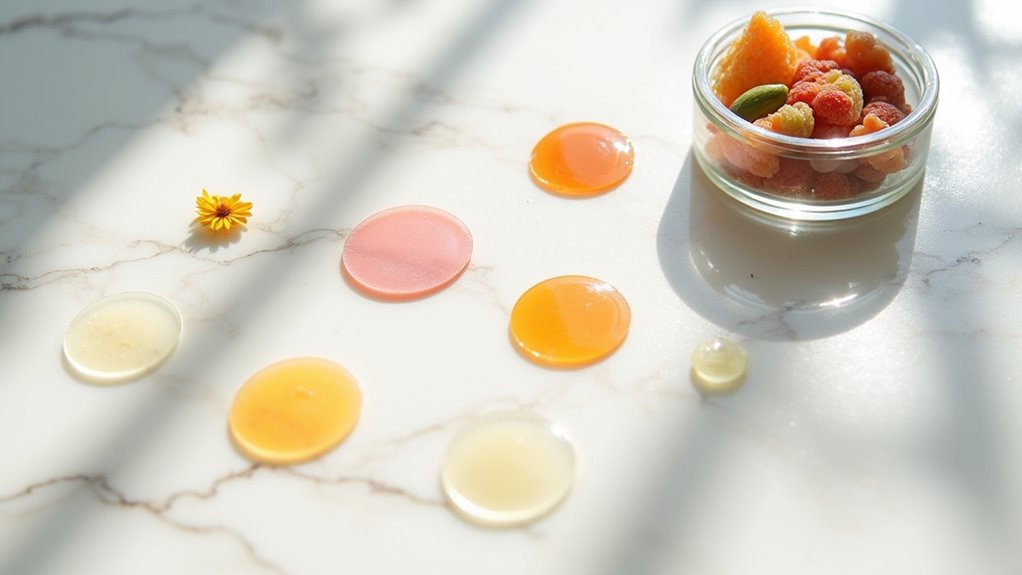
Choosing the right acne patch can make a significant difference in your skincare routine, especially since various types target different stages of blemishes.
Here are three common types of acne patches:
- Hydrocolloid Patches: Best for mature pimples with visible pus, these patches absorb excess oil and fluids, creating a moist environment that promotes healing.
- Acne Treatment Patches: Containing active ingredients like salicylic acid, these patches target early-stage blemishes by reducing inflammation without absorbing fluids.
- Combination Patches: Some patches blend hydrocolloid with active ingredients, offering a dual-action approach for various types of acne and skin cells. Additionally, these patches often contain salicylic acid to enhance their effectiveness against breakouts.
Understanding which type of patch suits your needs is key to effective acne treatment and can help you achieve clearer skin.
Comparing Hydrocolloid and Microdart Technology

Acne patches have evolved considerably, with hydrocolloid and microdart technologies leading the charge in effective treatment options.
Hydrocolloid patches work by creating a moist environment that absorbs fluids and pus from surface-level pimples, making them ideal for treating zits that have come to a head.
Hydrocolloid patches create a moist environment that effectively absorbs fluids from surface-level pimples, perfect for treating zits at their peak.
On the other hand, microdart patches utilize tiny self-dissolving darts to deliver active ingredients like salicylic acid directly beneath the skin, effectively targeting early-stage or deep acne.
While both can contain similar ingredients, their methods differ greatly; hydrocolloid focuses on absorption, whereas microdart emphasizes penetration.
Understanding your specific acne type is vital, as hydrocolloid excels with visible pus while microdart helps prevent emerging blemishes.
Choose wisely for best treatment.
Effectiveness of Hydrocolloid Patches for Acne
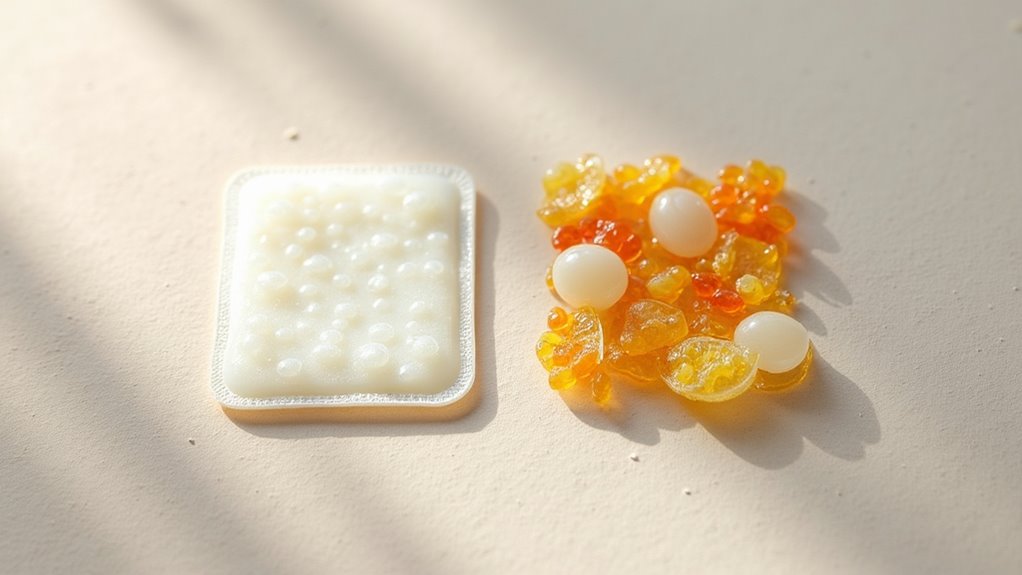
When it comes to treating surface-level breakouts, hydrocolloid patches prove to be highly effective. These patches create a moist environment that allows them to absorb fluids and clear dirt from your pimples, considerably reducing acne severity.
Here’s how they work:
- Protective Barrier: They form a shield over the pimple, minimizing the risk of infection and irritation.
- Fluid Absorption: Hydrocolloid patches draw out pus and impurities, providing visible results after use.
- Faster Healing: Studies show they promote quicker healing compared to traditional treatments. Additionally, regular use of glycolic acid products can enhance overall skin texture, complementing the benefits of hydrocolloid patches for exfoliation and clarity.
However, keep in mind that while hydrocolloid patches excel at tackling surface-level acne, they’re not suitable for deeper cystic acne or clogged pores.
Who Should Use Hydrocolloid Patches?

Hydrocolloid patches are perfect for anyone dealing with mature pimples that have visible white pus. They help reduce inflammation and protect your skin from excess oil and dirt. These patches work best for superficial zits, making them ideal for individuals who want discreet treatment. However, if you have sensitive skin or conditions like cystic acne, you might want to explore other options. Hydrocolloid technology is known for its ability to promote healing and draw out impurities, making it a popular choice among dermatologists.
| Skin Type | Benefits |
|---|---|
| Non-Sensitive Skin | Absorbs fluids, promotes healing |
| Superficial Zits | Creates a barrier, prevents picking |
| Excess Oil | Helps reduce breakouts |
| Everyday Use | Convenient, discreet treatment |
| Ideal Candidates | Those wanting fast, effective care |
Hydrocolloid patches are a smart choice for effective acne management.
Alternative Acne Treatment Options
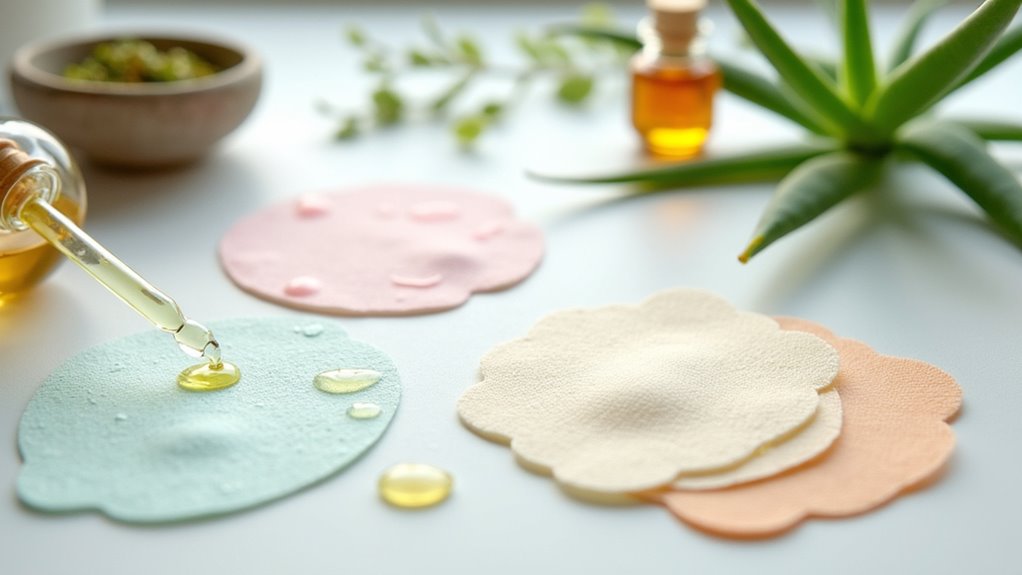
If you’re looking for effective ways to tackle acne beyond hydrocolloid patches, there are plenty of alternative treatment options available. Here are three to evaluate:
- Topical Treatments: Products with active ingredients like salicylic acid and benzoyl peroxide help to prevent breakouts by unclogging pores and reducing inflammation.
- Natural Remedies: Tea tree oil and witch hazel offer antibacterial properties, potentially alleviating mild acne symptoms.
- Oral Medications: Antibiotics and hormonal treatments target underlying issues related to excess oil and inflammation for moderate to severe cases.
Incorporating a consistent skincare routine, including regular cleansing and moisturizing, is essential for managing acne effectively. Furthermore, using essential oils like tea tree oil can provide additional benefits in acne treatment due to their antibacterial properties.
While hydrocolloid acne patches work well for spot treatment, exploring these alternatives can enhance your overall acne management strategy.
Frequently Asked Questions
Is There a Difference Between Pimple Patches and Hydrocolloid Patches?
Yes, there’s definitely a difference between pimple patches and hydrocolloid patches.
While hydrocolloid patches are designed to absorb fluids and create a moist environment for healing, regular pimple patches often contain active ingredients like salicylic acid that target inflammation.
If you’ve got a mature pimple with pus, a hydrocolloid patch is your best bet.
For early-stage zits without visible fluid, a medicated patch can help reduce redness and swelling effectively.
What Is the White Stuff That Comes Out of Pimple Patches?
The white stuff you see on your pimple patch is primarily pus, which consists of dead white blood cells, bacteria, and debris from the inflamed pimple.
When you apply a patch, it creates a moist environment that helps draw out this fluid, promoting healing.
If you notice white material on the patch, it means it’s effectively doing its job by extracting impurities, which can speed up the healing process of your pimple.
What Is the Best Ingredient in Pimple Patches?
Think of your skin as a garden; the best ingredients in pimple patches act like skilled gardeners, nurturing and healing.
If you’re tackling mature zits, hydrocolloid patches are your go-to, gently pulling out pus and promoting recovery.
For early-stage pimples, salicylic acid offers targeted relief by unclogging pores.
If you prefer a natural approach, tea tree oil‘s antibacterial properties help.
Choose based on your acne type, and watch your garden flourish!
When Should You Not Use Hydrocolloid Patches?
You shouldn’t use hydrocolloid patches if you have very sensitive skin, as they can cause irritation or allergic reactions.
They’re also ineffective for treating clogged pores, blackheads, or cystic acne, which requires deeper treatment.
If you’re prone to skin irritation, it’s best to avoid prolonged use, since that could worsen your sensitivity or discomfort.
Always consider your skin type and the specific acne issues you’re facing before applying these patches.
Conclusion
Just like a knight in shining armor, hydrocolloid patches swoop in to shield your skin from the battle of acne. They create a protective barrier, allowing healing to take place while drawing out impurities. While alternatives exist, these patches stand firm as trusted allies in your skincare quest. So, whether you’re facing a dragon-sized pimple or a pesky little blemish, don’t underestimate the power of your trusty hydrocolloid patch on the journey to clear skin.
Claire has a knack for turning complex dermatological concepts into engaging, easy-to-understand articles. Her work primarily focuses on creating detailed reviews and thought-provoking articles in the “Vetted” category. Claire’s writing not only informs but also inspires our community to try new skincare solutions.
